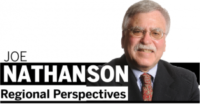
Building the ‘Third City’
By Joe Nathanson
June 29, 2023
Seated in a meeting room on the penthouse level of the 12-story Tenable Building in the Merriweather District of downtown Columbia, about 50 urbanists of various stripes were learning about the ongoing plans for this center of growth in Howard County. Those in attendance were members of the Baltimore and Washington chapters of Lambda Alpha International, the land economics honorary society.
The host for the occasion was Greg Fitchitt, the regional president of the Howard Hughes Corporation (HHC), with responsibility for the next phase of the development of downtown Columbia.
It may be useful to review the corporate genealogy of HHC. This national developer came into being upon acquiring the assets of General Growth Properties in the years following the latter’s bankruptcy in 2009. General Growth, in turn, was the successor to the Rouse Company, founded by Baltimore’s James W. Rouse.
As Fitchitt relayed to the group, if Columbia with a population of nearly 120,000 were an
incorporated place it would be Maryland’s second largest city, only behind Baltimore. Jim Rouse, a pioneer of the “new towns” movement of the 1960s, felt that he had realized most of his goals in creating a new type of suburban community, providing a welcoming, inclusive, and environmentally sensitive development. However, according to Fitchitt, Rouse’s one regret was that Columbia had never developed a “real downtown.”
The Howard Hughes team is out to change that. The Tenable Building where the meeting was held is part of that effort. HHC has managed to lease six floors of the 320,000 square feet office building, at a time when attracting new office users is challenging everywhere, to Tenable, a cybersecurity company.
Another significant component of the emerging downtown has been the major renovation of the Merriweather Post Pavilion, which has hosted musical headliners for over 50 years. Originally designed by the then-little known architect Frank Gehry, this entertainment facility, now expanded to a 19,300-seat capacity, has been cited by Rolling Stone magazine as one of the best outdoor concert venues in the nation.
The Merriweather District is envisioned as a “walkable, urban core with shopping, dining and entertainment among residential and office buildings” and serving as a catalyst for arts and cultural events for the region.
Delivery of the residential component is well underway. The Marlow Building, a 472-unit apartment structure in the heart of the district, is now leasing as is the Juniper Building, described as offering “380+ luxury apartments with modern amenities” located “amongst trees, paths and parkways.”
A new Busboys and Poets outpost offers not only eating and drinking but events space and further opportunities for community gatherings. And pet owners will have to learn about Bark Social, a hangout for dogs and dog lovers.
The full build-out of downtown Columbia will encompass, in addition to Merriweather, the Lakefront and Central districts. On almost 400 acres, the developers are projecting 1.9-million square feet of office and retail space and nearly 1,700 multi-family units. The Lakefront District is billed as Columbia’s “health and wellness” district with a new 86,000 square feet medical office building, along with 76,000 square feet of restaurant and retail space along with 650 new residential units.
The crowning jewel of the Central District, near the site of the original Rouse Company building, is expected to be the Howard County Public Library. Still a few years away from beginning construction, the 100,000 square feet library, budgeted at $144 million, will feature an auditorium, flexible community space, a digital lab and opportunities for guest speakers, author talks and other attractions.
Some limitations to the full realization of a downtown experience were raised, most notably the lack of strong regional transit connections, whether bus or rail. David Benn, an architect in the Baltimore office of Quinn Evans, raised questions about the overall cohesiveness of the plan, pointing to the significant physical separations between the three districts and the barriers to pedestrian movement presented by the major arterial roadways running through Columbia.
These limitations notwithstanding, the Howard Hughes Corporation is convinced that, with the growth anticipated for Columbia, it is taking important strides towards creating that “Third City” in relation to Washington, D.C., and Baltimore and coming closer to realizing the vision of Columbia’s founder, Jim Rouse.
Joe Nathanson is the retired principal of Urban Information Associates, a Baltimore-based economic and community development consulting firm. Since 2001, he has written a monthly column for The Daily Record and can be contacted at urbaninfo@comcast.net